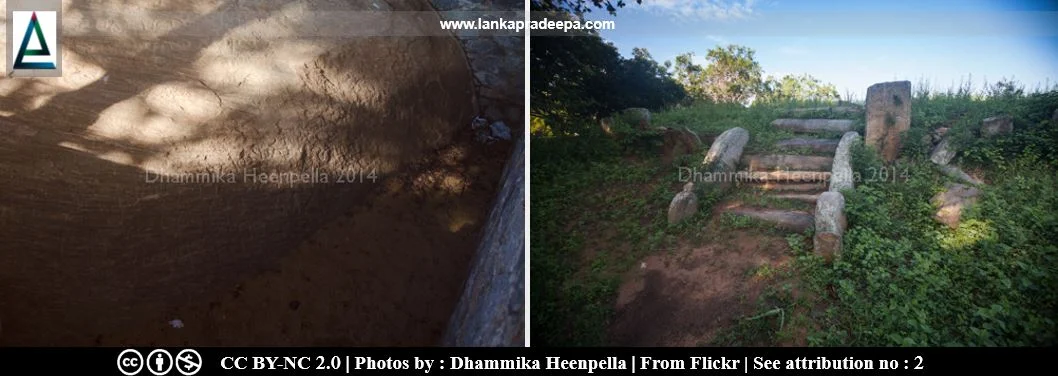
Godavaya Gothapabbata Viharaya (Sinhala: ගොඩවාය ගෝඨපබ්බත විහාරය) is a Buddhist temple situated on a rocky cliff by the side of the Ambalantota sea near the mouth of Walawe Ganga river in Hambantota District, Sri Lanka. The temple is historically and archaeologically important as the only record and evidence regarding the ancient Godavaya Port at Ambalantota is found here (Abeyawardana, 2004).
History
The establishment of Gothapabbata Vihara is attributed to Gotabhaya, the ruler of Rohana early in the 2nd century A.D. (Abeyawardana, 2004; Nicholas, 1963). The inscription of Gamini Abaya of the 1st-2nd century A.D. (see the below "Inscriptions" section) which is in the temple premises reveals the name of the area as Godapavata (Nicholas, 1963; Paranavitana, 1983). In a later 6th century inscription, this temple is named Godava-vahera (Nicholas, 1963).
Ancient Godavaya Port
The inscription of Gamini Abaya confirms the fact that there was an ancient port in Godawaya. The Department of Archaeology (Sri Lanka) jointly with a team of German archaeologists excavated the Godavaya temple and the surrounding area in the 1990s (Abeyawardana, 2004; Dimucci, 2015; Gaur et al, 2011). During the excavations, they found out a number of Roman and other foreign coins and artifacts which lead them to identify this site as an important trade center or emporium in ancient times (Abeyawardana, 2004; Dimucci, 2015).
Godavaya Shipwreck
The shipwreck of Godawaya was discovered in 2003 by two fishermen and they brought it to the attention of German archaeologists who were excavating the nearby 2nd century A.D. Godavaya port and the Gothapabbata Buddhist monastery (Dimucci, 2015; Muthucumarana et al., 2014) In 2010 an excavation by an international team of maritime archaeologists brought to light the remains of a shipwreck (Muthucumarana et al., 2014). The analysis of artifacts and radiocarbon dating of wood fragments from the site revealed that the wreck belongs to a time period between the 2nd B.C. - 2nd centuries A.D. (Gaur et al., 2011; Muthucumarana et al., 2014). This is probably the oldest known shipwreck in the Indian Ocean.
Inscriptions
The inscription of Gamini Abaya
This inscription is found inscribed on the face of the main rock boulder at the site. A fragment of a record belonging to about the 6th century has also been found on the same boulder (Paranavitana, 1983).
The inscription consists of two lines and written in the scripts of the 1st or 2nd century A.D. (Abeyawardana, 2004; Paranavitana, 1983). It records that King Gamini Abhaya [probably King Gajabahu I (114-136 A.D.) or one of his predecessors such as Amanda Gamini Abhaya (22-31 A.D.)] donated the customs duties of Godapavata Port to the Vihara at the site (Abeyawardana, 2004; Nicholas, 1963; Paranavitana, 1983). This is the only concrete evidence that confirms the ancient port in the Godavaya area (Abeyawardana, 2004).
Transcript: (1) Siddham [|*] Godapavata-patanahi su[ka] su[ri]yi (2) raja Gamani Abaya viharata dini
Translation: Success! The customs duties of the port of Godapavata, King Gamani Abhaya granted to the Vihara.
Citation: Paranavitana, 1983. p.101.
The temple
The ruins of ancient buildings and structures (such as pillars, pillar foundations, and brick monuments) found in the temple premises indicate the antiquity of Gotapabbata Viharaya. The ancient Stupa at the highest point of the rock has been renovated around 1920 (Abeyawardana, 2004). The preaching hall and the monks' residence have been added to the temple in the 1930s (Abeyawardana, 2004).
References
1) Abeyawardana, H.A.P., 2004. Heritage of Ruhuna: Major natural,
cultural and historic sites. Colombo: The Central Bank of Sri Lanka.
ISBN: 955-575-073-4. p.115.
2) Dimucci, A.M., 2015. An Ancient Iron Cargo in the Indian Ocean: The Godavaya Shipwreck (Doctoral dissertation submitted to the Office of Graduate and Professional Studies of Texas A&M University). pp.3-5,7-8.
3) Gaur, A.S., Muthucumaran, R., Chandraratne, W.M., Orillandeda, B.C., Manders, M., Karunarathna, S., Weerasinghe, P., Dayananda, A.M.A., Zainab, T., Sudaryadi, A. and Ghani, K.A.B.A., 2011. Preliminary assessment of an early historic (2000-year-old) shipwreck at Godawaya, Sri Lanka. Journal of the Australasian Institute for Maritime Archaeology, The, 35, pp.9-17.
4) Muthucumarana, R., Gaur, A.S., Chandraratne, W.M., Manders, M., Rao, B.R., Bhushan, R., Khedekar, V.D. and Dayananda, A.M.A., 2014. An early historic assemblage offshore of Godawaya, Sri Lanka: evidence for early regional seafaring in South Asia. Journal of Maritime Archaeology, 9(1), pp.41-58.
5) Nicholas, C. W., 1963. Historical topography of ancient and medieval
Ceylon. Journal of the Ceylon Branch of the Royal Asiatic Society, New
Series (Vol VI). Special Number: Colombo. Royal Asiatic Society (Ceylon
Branch). p.67.
6) Paranavitana, S., 1983. Godavaya Rock Inscription. Inscriptions of Ceylon, Late Brahmi Inscriptions, 2 (part 1). Archaeological Survey of Sri Lanka. pp.101-102.
Location Map
This page was last updated on 4 June 2022

 .
.
